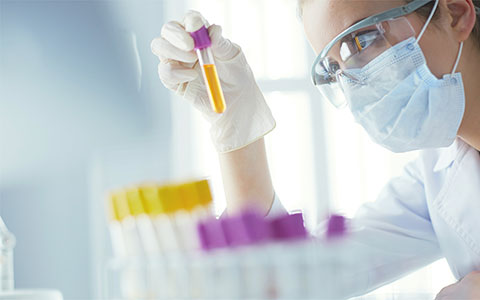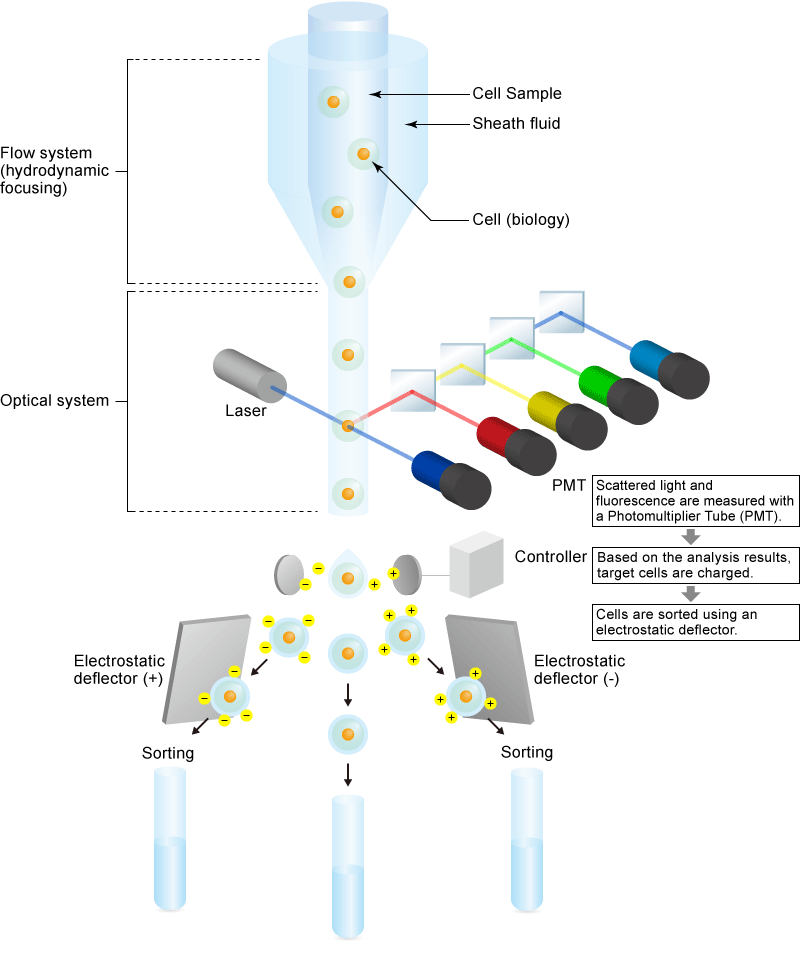Flow cytometry is an essential technique for cell analysis. This article describes the fundamental principles of flow cytometry, the instrumentation involved, the mechanism of cell sorting, and its common applications.

What is flow cytometry?
Flow cytometry is a powerful cell analysis technique introduced in the 1950s. It involves suspending cells in a fluid and forcing them to flow at high speed, single-file, through a detection point. As each cell passes this laser interrogation point, it is analyzed individually.
Flow cytometry measures various characteristics, including cell size, internal complexity, and fluorescence intensity. This provides detailed, quantitative information about individual cells within a heterogeneous population.
What is a flow cytometer?
A flow cytometer is an instrument that utilizes flow cytometry technology. Instruments with the added capability of physically separating cells based on their properties are known as cell sorters or FACS (Fluorescence-Activated Cell Sorters).
While the terms are sometimes used interchangeably, a cell sorter is specifically a flow cytometer that can isolate and collect specific cell populations identified during analysis. This process of isolation and collection is called "sorting."
Flow cytometers consist of three major components: a fluidics system, an optics system, and an electronics system. The fluidics system transports the cells. The optics system consists of lasers and optical filters to illuminate the cells and collect the resulting light signals. The electronics system converts the detected light signals into digital data for computer analysis.
In the fluidics system, cells are forced into a single-file stream using a buffer called "sheath fluid." This process is known as hydrodynamic focusing. In the optical system, a laser beam illuminates this stream of cells. The resulting scattered light and fluorescence signals are captured by detectors, such as Photomultiplier Tubes (PMTs), providing information about each cell.
Based on this information, a cell sorter applies a precise electrical charge to droplets containing the target cells. These charged droplets are then deflected by high-voltage plates (deflection plates) into separate collection tubes.
Because cells are measured within a stable, undisturbed laminar flow, it is possible to analyze and sort them without causing damage.

Flow cytometers are used for applications like cell cycle evaluation (based on DNA content), cell surface marker analysis (using fluorescently labeled antibodies), and the analysis of intracellular proteins or other macromolecules. They are also, as noted, used for sorting specific cells.
Experimental Design for Cell Biology Studies by Flow Cytometry
When designing cell biology experiments using flow cytometry, the initial step is to plan the assignment of fluorescent dyes to each antibody.
To prevent spectral overlap (where fluorescence from one dye "spills over" into another's detection channel) and ensure accurate cell identification, dyes are assigned carefully. This involves considering their excitation and emission spectra, brightness, and the specific lasers and filters installed in the flow cytometer.
Next, follow the steps in the cell staining protocol. Cell staining can be done by direct staining, indirect staining, or intracellular staining. The staining method is selected according to the type of cell to be measured and the target of interest (or parameters being measured).
After staining, the sample must be filtered to remove cell clumps and other aggregates. Aggregates can clog the delicate fluidics system and compromise data quality.
Following filtration, the sample is ready for flow cytometry analysis.
Flow cytometer data analysis
Flow cytometers are widely used in cell biology, immunology, and molecular biology. Fluorescent molecules (fluorochromes) are used to analyze cell surface markers, intracellular components, and visualize cellular functions.
In molecular biology, flow cytometers are essential for detecting cells expressing specific markers. For example, they can quantify cells engineered to express Green Fluorescent Protein (GFP) or other fluorescent proteins, allowing researchers to track gene expression. In immunology and hematology, flow cytometry is indispensable for analyzing complex cell populations from samples like blood or bone marrow, enabling the diagnosis and monitoring of diseases such as leukemia or HIV. This detailed analysis of the immune system is a cornerstone of modern biomedical research.
Compared to fluorescence microscopy, flow cytometry offers several key advantages: high-throughput analysis (analyzing thousands of cells per second), the ability to measure multiple parameters simultaneously, and highly quantitative data.
- Related words:
Reference (Japanese site)
- 高分子学会 - フローサイトメトリー(Flow Cytometry)
(https://www.spsj.or.jp/equipment/news/news_detail_42.html) - Thermo Fisher - フローサイトメーターの仕組み
(https://www.thermofisher.com/jp/ja/home/life-science/cell-analysis/cell-analysis-learning-center/molecular-probes-school-of-fluorescence/flow-cytometry-basics/flow-cytometry-fundamentals/how-flow-cytometer-works.html) - Cell Signaling - フローサイトメトリーの概要
(https://www.cellsignal.jp/applications/flow-cytometry/flow-cytometry-overview)


